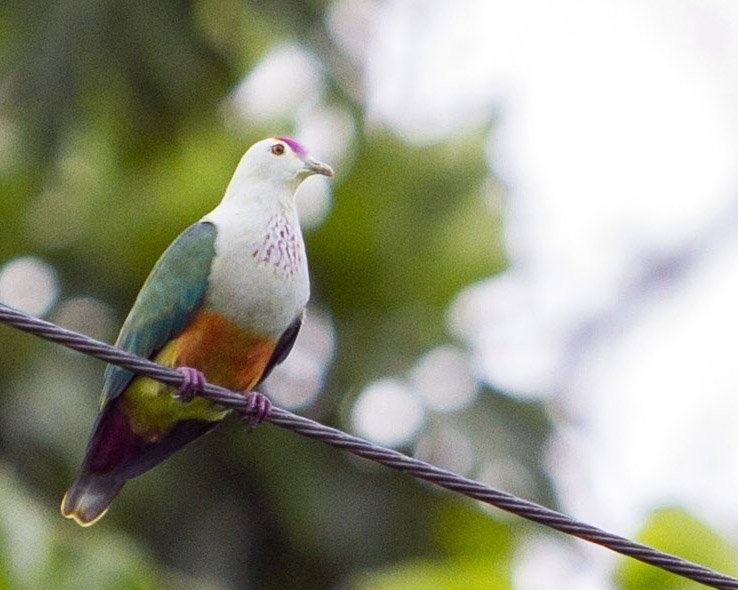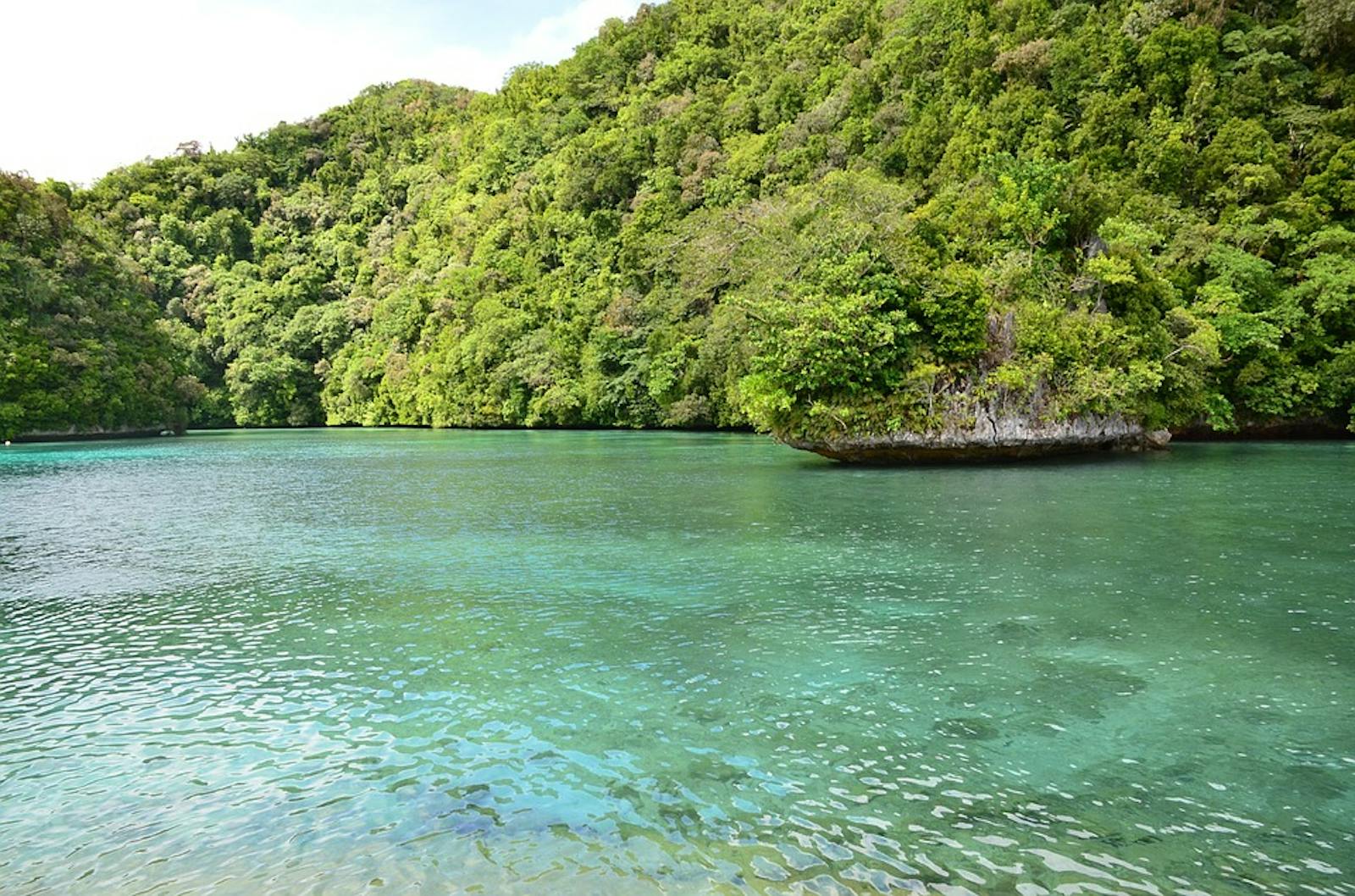Palau Tropical Moist Forests
The ecoregion’s land area is provided in units of 1,000 hectares. The conservation target is the Global Safety Net (GSN1) area for the given ecoregion. The protection level indicates the percentage of the GSN goal that is currently protected on a scale of 0-10. N/A means data is not available at this time.
Bioregion: Palau & Caroline Tropical Islands (OC8)
Realm: Oceania
Ecoregion Size (1000 ha):
46
Ecoregion ID:
627
Conservation Target:
94%
Protection Level:
3
States: Palau
An incredible 586 islands make up the archipelago of Palau in western Micronesia. The forests that cling to the jagged limestone rock islands and cover the larger eroded islands are the most biodiverse in Micronesia due, in part, to the group being closest to source regions of Indonesia, New Guinea, and the Philippines. However, the islands remain far out in the ocean and many plants and animals have evolved distinct forms in Palau, including the Giant white-eye, Palau fruit dove, and two species of Palauan fruit bat.
An incredible 586 islands make up the archipelago of Palau in western Micronesia. The forests that cling to the jagged limestone rock islands and cover the larger eroded islands are the most biodiverse in Micronesia due, in part, to the group being closest to source regions of Indonesia, New Guinea, and the Philippines. However, the islands remain far out in the ocean and many plants and animals have evolved distinct forms in Palau, including the Giant white-eye, Palau fruit dove, and two species of Palauan fruit bat.

The flagship species of the Palau Tropical Moist Forests ecoregion is the Palau fruit dove. Image credit: Devon Pike, Creative Commons
Forest communities are distinct on the upland volcanic soils on the older, larger islands (Babeldaob, parts of the island of Koror), on upland limestone bedrock, on atolls, and on lowland limestone bedrock and offshore islets. The forests are home to 972 native plants, of which at least 178 are unique to the archipelago, including orchids such as Bulbophyllum hatusimanum, palms like Ponapea palauensis, and Sterculia palauensis.
The upland forests of Palau are the most species diverse in Micronesia harboring many endemic species. Campnosperma brevipetiolata is one of most common canopy trees in the upland forest. Other common species include Parinari corymbosa, Alphitonia carolinensis, Rhus taitensis, Elaeocarpus carolinensis, Serianthes kanehirae, Semecarpus venenosus, Calophyllum inophyllum, Gmelina palawensis, and Pterocarpus indicus. Common understory species include Pandanus aimiriikensis, Ixora casei, Eugenia cuminii, Osmoxylon oliveri, Manilkara udoido, Symplocos racemosa, and Cyathea lunulata. Palauan forests have six native palm species.
Atoll forests are found toward the interior of the larger, wetter uninhabited atolls and along coasts of the high islands. Casuarina litorea trees and Scaevola taccada shrubs are dominant species. Limestone forest is found on the coral islands of Peleliu, Angaur, and the Rock Islands. The species composition varies from island to island. Common species include Intsia bijuga, Psychotria spp., and Clerodendrum inerme. The Rock Island forest is a subtype of limestone forest that rich and distinct with endemic palms, such as Gulubia palauensis and Ptychosperma palauensis, and trees, such as Semecarpus venenosus, Premna obtusifolia, and Bikkia palauensis. Pandanus spp. and Dracaena multiflora are common understory plants.
The archipelago supports 972 native plant species with 178 endemics, 51 native land birds with 16 endemics, 41 native reptile and amphibians with 12 endemics, and 42 freshwater fish with 2 endemic species. There are species of fruit dove, ground dove, swiftlet, nightjar, kingfisher, flycatcher, cicadabird, bush-warbler, fantail, morningbird, and scops owl that are named after Palau. The giant white-eye is one of the largest of the world’s far-flung white-eyes. The Palau fruit bat Pteropus pelewensis, sheath-tailed bat, and the extinct large palau flying fox Pteropus pilosus are the archipelago’s only mammals.
An endemic amphibian is the Palau frog. Reptiles unique to Palau also include the Palau slender gecko, the Palau ghost gecko, and the Palau dog-faced mud snake. There are at least 300 endemic land snail species and an endemic subspecies of golden jellyfish in inland brackish lakes.
Forest cover is presently around 75%. Native forest has been cleared for settlement, subsistence agriculture, and plantations of sugar cane and pineapple. Rats, mice, feral cats, introduced crab-eating macaques (monkeys), and monitor lizards eat native wildlife and non-native cockatoos threaten endemic palms with their feeding.
Bird hunting, particularly for large pigeons, continues to threaten wild populations despite efforts to curb the practice. Palau has one of the world’s most advanced approaches to biodiversity conservation with over 40 marine and terrestrial protected areas already established, and recovery and management plans for key threatened species and habitat in place. State level initiatives are a foundation for the protected area network. Palau’s network of protected areas covers at least 25% of its terrestrial habitats.
The priority conservation actions for the next decade are to: 1) support the establishment of state-managed protected areas on Ngeriungs Island in Kayangel, Fana Island in Sonsorol and in Peleliu’s Important Bird Area (IBA); 2) strengthen protection of the Kmekumer Reserve for nesting grounds of Hawksbill Turtles and Palau megapode; and 3) strengthen preventive measures to keep the brown tree snake and little red fire ant from invading Palau.
Citations
Holm TT, AL Isechal, E Matthews, A Gupta. 2006. Important Bird Areas in Palau: Protecting Palau’s Natural Heritage. Palau Conservation Society, Koror, Palau.
The Republic of Palau. 2016. The Republic of Palau Revised National Biodiversity Strategy and Action Plan 2015-2025: Promoting Wise Development to Achieve Conservation and Sustainable Use of Biodiversity, Strategic policy interventions to promote long-term cultural, economic and environmental sustainability through protection of biodiversity. The Palau Conservation Society, Policy and Planning Department, Koror.
Zicus S. 2018. Palau tropical moist forest. Accessed 1 June 2018 at https://www.worldwildlife.org/ecoregions/oc0110



